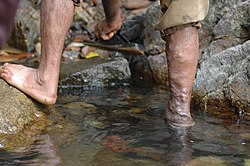Chronic venous insufficiency
This is the most common complication of venous varicosity. The term is used for signs and symptoms associated with chronic venous hypertension.
Pathogenesis[edit | edit source]
The basis of formation is the rise of pressure, which arose as a result of valence incompetence, reflux, obstruction.. The most serious forms are found in post-thrombotic syndrome, milder forms are caused by varixes. In 80% it results from deep vein thrombosis (such as post-phlebitic syndrome), in the other 20% primary varicose, valve agens and congenital AV shorts are applied. The main factors for this are two - muscle pump failure and valvular insufficiency with reflux. It can be in the compensated form - the muscle pump is able to cope with volume overload, or decompensated form - skin changes - the muscle pump can no longer cope, venous hypertension develops.
Clinical picture[edit | edit source]
A classic sign is a permanent swelling that does not respond to the lying position. He is often accompanied by skin hyperpigmentation, eczema, subcutaneous fibrosis (lipodermatosclerosis), white atrophy and ulceration, as well as pressure and tightness in his limbs and night cramps. Another manifestation may be called corona phlebectatica - dilated red to blue veins at the inner ankle. At the most severe stage of insufficiency, ulcus cruris occurs.
| C - clinical classification: | |
|---|---|
| C0 | No visible or palpable signs of venous disease |
| C1 | Teleangiectasia, reticular varices |
| C2 | Varices of tribal veins |
| C3 | Swelling |
| C4a | Pigmentation, eczema |
| C4b | Lipodermatosclerosis, white atrophy |
| C5 | Healed ulcus |
| C6 | Active ulcus |
| S | Symptomatic |
| A | Asymptomatic |
| E - etiological classification: | |
| Ec | congenital |
| Ep | primary |
| Es | secondary |
| En | no venous etiology |
| A - anatomical classification: | |
| As | surface veins |
| Ap | perforators |
| Ad | deep veins |
| An | no vein localisation found |
| P - pathophysiological classification: | |
| Pr | reflux |
| Po | obstruction |
| Pr,o | reflux and obstruction |
| Pn | undetected |
Therapy[edit | edit source]
Conservative[edit | edit source]
- in postthrombotic syndrome - warfarin to prevent relapse of thrombosis
- lifestyle changes (exercise, weight reduction, regular faeces...)
- compression, venotonics
Sclerotherapy[edit | edit source]
Surgical[edit | edit source]
- removal of varicose veins, interruption of perforators,...
- Palme reconstruction - at the closure of the external or communal pelvic vein, the v. femoralis on the affected side is sewed crosswise in the v. saphena magna from the other side
Skin changes[edit | edit source]
Skin changes are divided into 3 grades:
- Grade 1 - corona phlebectatica paraplantaris, perimaleol edema;
- Grade 2 - swelling of the lower limb, skin changes (hyperpigmentation, dermatitis varicosa, hypodermatitis, dermatosclerosis);
- Grade 3 – ulcus cruris venosum.
Ulcus cruris venosum[edit | edit source]
It is a chronic leg ulcer, the predilection point being the landscape above the ankles. It arises as a result of chronic venous insufficiency. Otherwise, quite trivial trauma tends to be a provocative factor.
Treatment of leg ulcer[edit | edit source]
Treatment has to be complex.
- walking with compression (intermittent pneumatic compression regarding immobile patients)
- external treatment
- poultices with chloramine, surrounding ulcers with poultices with zinc paste, gentian violet, enzyme preparations (collagenasa)
- apply granulating (AgNO3) and then epithelising agents (boric grease) to cleaned ulcers
- surgical treatment
- ligation of an insufficient perforator, extirpation of massive varicose
- excision of callosial edges of ulcers
- transplantation of skin graft
- farmacotherapy – pentoxyfiline
References[edit | edit source]
Referenced articles[edit | edit source]
Sources[edit | edit source]
- BENEŠ, Jiří. Studijní materiály [online]. [cit. 30.12.2022]. <http://jirben.wz.cz>.
- ČEŠKA, Richard, ŠTULC, Tomáš, Vladimír TESAŘ a Milan LUKÁŠ, et al. Interna. 3. edition. Stanislav Juhaňák - Triton, 2020. 964 pp. pp. 239-242. ISBN 978-80-7553-780-5.


